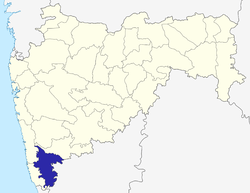Battle of Kolhapur
Battle of Kolhapur was a land battle that took place on December 28, 1659 near the city of Kolhapur, Maharashtra, India between the Maratha Chhatrapati Shivaji.
| Battle of Kolhapur | ||
|---|---|---|
| Part of the Imperial Maratha Conquests | ||
| Date: December 28, 1659 | ||
| Place: Kolhapur, Maharashtra, India | ||
| Outcome: Decisive victory for Maratha Empire | ||
| Combatants | ||
| |
Adilshahi forces | |
| Commanders | ||
| Shivaji, Netaji Palkar | Rustam Zaman | |
| Strength | ||
| Casualties | ||
The battle is known for brilliant movement of flanks by Shivaji similar to Uzbek tactics of Babur against Rana Sangha.
Background
Shivaji had killed Afzal Khan and routed his army in the battle of Pratapgarh (10 November 1659). He took advantage of this victory and in a great offensive took a large hilly tract running about 200 km under his command. A number of forts like Vasota fell to Marathas. By December, 1659 Shivaji appeared near Panhala fort. Rustam Zaman was directed from Bijapur. He arrived near Miraj in the vicinity of Kolhapur on 27 December 1659.
Battle
Composition of Adilshahi forces
Rustam Zaman was assisted by other chieftains Fazal Khan, Malik Itbar, Sadat Khan, Yakub Khan, Aankush Khan, Hasan Khan, Mulla Yahya, Santaji Ghatage. It consists of selected cavalry of Adilshahi which was well known. In addition elephants were deployed as first line of defense. The centre was commanded by Rustam Zaman himself, left flank by Fazal Khan, right flank by Malik Itbar. Fateh Khan and Mullah Yahya were on the rear guard.
Composition of Maratha forces
Shivaji was assisted by Maratha Cavalry leader Netaji Palkar, Sardar Godajiraje Jagtap, Hiroji Ingale, Bhimaji Wagh, Sidhoji Pawar Jadhavrao, Hanmantrao Kharate, Pandhare, Siddi Hllal, and Mahadik. Center was commanded by Shivaji himself. Siddi Hilal and Jadhavrao were on left flank. Ingale and Sidhoji Pawar on right flank. Mahadik and Wagh on the rear guard. Netaji Palkar was off the centre.
Movement and clash of forces
Rustam Zaman was planning to move towards Panhala fort. Shivaji anticipated this movement and in a quick dash appeared before Adilshahi forces in the early morning of 28 December 1659. And attacked the enemy. Shivaji charged the center. Other Maratha commanders attacked respective flanks. In a hard battle, Adilshahi forces were scuttled. By afternoon Rustam Zaman had fled the field.
Outcome
Shivaji gained a large territory and secured front of his emerging empire. Adilshahi forces lost about 2000 horses and 12 elephants to the Marathas. The Marathas under Shivaji continued to harass and conquer more Adilshahi territory. In one of the incidences, Shivaji tried to conquer an Adilshahi fort named Khelna but the terrain of the fort was difficult; conquering the fort was easier said than done. The Adilshahi garrison at the fort was also defending the fort valiantly. Then, Shivaji came up with a plan. Accordingly, a group of Marathas went up to the fort and convinced the Adilshahi chief (killedar) at the fort that they were not content with the rule of Shivaji and thus, had come to serve the Adilshah. The Marathas were successful and the next day, they revolted and caused total chaos inside the fort. Simultaneously, Shivaji attacked the fort from outside and in no time captured the fort. Shivaji renamed the fort as Vishalgad.
Casualties
The total casualties of this battle and also the Battle of Pratapgarh was 7000 on Adilshahi side and 2000 on Maratha side.
References
- Grant Duff - History of Marathas
- S.D.Samant - Vedh Mahamanvacha
